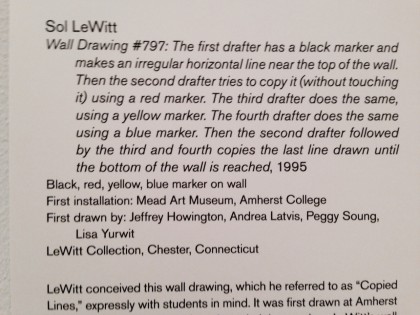It really irks me when I hear someone talk about some piece of architecture that “rises to the level of art.” Although I have a lot of respect for art, from my modest perspective, architecture operates at a much richer and more complex level. It involves many more people and must address a myriad of technical and functional issues as well as visual and sensory ones. It requires getting outside oneself and creating something bigger than just personal expression.
Is it possible that sometimes art might “rise to the level of architecture”? There is something in the work of Sol LeWitt that makes me think so.
I made several visits to a great exhibition at the Blanton Museum at UT Austin this spring that made me see Sol LeWitt’s work in a slightly different way. The show emphasized the relationship between him and Eva Hesse and seemed to take the art out of the realm of just self-absorption and make it something that addressed issues the two of them were working on together. This is like the kind of collaboration that often occurs in architecture, and which has always seemed to me much more a team sport than art.
I’ve long admired Sol LeWitt’s discovery that what he did as an artist was not to make the art, but rather to produce the idea for it and to create instructions for others to actually fabricate it. At a certain stage of his career, when you bought one of Sol LeWitt’s works, you received a few pages of instructions detailing how to make it. There are hundreds of wall drawings in existence now that involved active participation by their owners who purchased the instructions and sought out fabricators who then followed the directions.
The instructions go something like this: “Have a person draw a non-straight line at the top of the wall in black crayon. Then red, then yellow…” etc. The result is that dozens of people might actually be involved in making the art and would receive credit. (LeWitt insisted those makers get acknowledgement for their contribution.)




Some friends of mine had a house in which they, in consultation with LeWitt’s studio, hired a bunch of art students to produce one of his pieces for a specified wall. When they sold the house, the buyers had the option of buying the house with or without the art, even though it was on a permanent wall. The buyers chose not to fork out the extra bucks for the art, so the wall was painted over. My friends still have the instructions and can re-create the art somewhere else if they like.
What is it that an artist contributes? It’s not the actual making; it’s the idea. LeWitt established this notion as a breakthrough idea in the 1960s. Since then, many artists now have their stuff made by fabricators, particularly in sculpture. The hand of the other maker is evident, along with the ideas of the artist. In LeWitt’s mind, this approach expanded the art, as the maker’s hand is evident as well as the artist’s.
Isn’t this art “rising to the level of architecture”? We as architects seldom actually make our buildings ourselves. We are responsible for producing the ideas and creating a set of instructions so others can actually fabricate the artifact. In the end, the artifact shows the imprint of the architect, but also of the many people who were part of the making process.
It occurred to me in that Blanton show that Sol LeWitt was aspiring to make something that I find very beautiful in architecture. He was making instructions and giving them to someone else who would actually produce the final result. In the process he was growing beyond the traditional controlling role of the artist and acknowledging a collaborative role with both the user and the fabricator. That’s what architects do!
The University of Texas at Austin purchased the instructions for a Sol LeWitt piece in 2011 from Madison Square in New York and rebuilt it at the Austin campus. “Circle with Towers” was originally created in 2005, and then again at UT in 2012. Here is art aspiring to be architecture. (There is even a space inside that can be occupied, and it is meant to have people interacting actively with it.) This is art rising to the level of architecture. It is truly getting those two hands to come together: the visionary and the maker.


(For more on the “Circle with Towers”, click here: http://landmarks.utexas.edu/artistdetail/lewitt_sol)
I loved reading this article just at a time when I am agonizing over whether or not to charge a fee for using one of my designs or to just give them to anyone who would like to use them. What to do? Only the Shadow knows 🙂
Well said. Sol Lewitt’s mosaics at the M.I.T. Research Center are one of his last works and are an incredible and integral part of the building’s design.